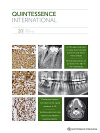Comparison of four-implant-retained overdentures and implant-supported fixed prostheses using the All-on-4 concept in the maxilla in terms of patient satisfaction, quality of life, and marginal bone loss: a 2-year retrospective study
Quintessence Int 51 (2020), No. 5 (23.04.2020)
Page 388-396, doi:10.3290/j.qi.a44368, PubMed:32253390
Objective: The purpose of the present study was to compare and assess
maxillary edentulous patients treated with four-implant-retained
overdentures and with implant-supported fixed prostheses using the
All-on-4 concept in terms of patient satisfaction, oral health-related
quality of life, and marginal bone loss.Page 388-396, doi:10.3290/j.qi.a44368, PubMed:32253390
Method and materials: Thirty-three patients treated with either maxillary four-implant-retained overdentures (n = 15) or with maxillary implant-supported fixed prosthesis using the All-on-4 concept (n = 18) were compared in terms of patient satisfaction, quality of life, and marginal bone loss. Independent sample t test was used to compare the two groups in terms of satisfaction, OHIP-14 scores, and marginal bone loss. The paired sample t test was used to compare bone loss at different time intervals. The comparison of marginal bone loss with regard to implant location was accomplished with the one-way ANOVA test. P values of < .05 were considered as statistically significant.
Results: No statistically significant differences were found between the two groups' OHIP-14 scores (P > .05). When patient satisfaction scores were evaluated, hygiene maintenance (P = .001) and pain scores (P = .001) were significantly higher in the implant-retained overdenture group than in the implant-supported fixed prosthesis group (P < .05). No statistically significant difference was observed between axial and tilted implants at both the 12-month (P = .59) and 24-month (P = .77) follow-up periods in the implant-supported fixed prosthesis group.
Conclusion: Four-implant-supported fixed prostheses with the All-on-4 concept and four-implant-retained overdentures present similar marginal bone loss and quality of life scores after 2 years of function. However, patients found overdentures easier to clean but more painful in comparison with the fixed prosthesis.

Comments